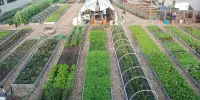Everyone is aware that eating fruits and vegetables is beneficial to one’s health. However, nowadays, supermarkets provide a bewildering assortment of choices: organic, conventional, CSAs, and local agriculture. Which ones are the most beneficial to your health?
A recent study published in the journal PeerJ in January examines how regenerative farming approaches such as soil-building techniques that avoid plowing, employ cover crops and grow a variety of crops improve the nutritional value of food.
The early investigation, which comprised 10 farms across the United States, found that crops grown on soil-friendly farms for at least five years had a richer nutritional profile than crops cultivated on conventional farms nearby. Certain minerals, vitamins, and phytochemicals that are beneficial to human health increased as a result of the study.
“We couldn’t find studies that related directly to how the health of the soil affects what gets into crops,” said lead author David Montgomery, a UW professor of Earth and space sciences. “So we did the experiment that we wished was out there.”
Montgomery created the study as part of his research for his upcoming book, “What Your Food Ate,” which will be released in June. Anne Biklé, his wife and co-author of the study and the future book, is a scientist.
To perform an experiment, the authors cooperated with farmers who practiced regenerative agricultural approaches. All of the participating farms, largely in the Midwest and the Eastern United States, consented to grow one acre of peas, sorghum, corn, or soybeans as a test crop to compare to the same crop grown on a neighboring farm using traditional agriculture.
Increasing soil nutrition in a more holistic way that gardeners can ensure that plants never go without the nutrients and trace elements they require, resulting in more nutritionally dense plants.
In the summer of 2019, co-author Ray Archuleta, a retired soil conservation specialist with the United States Department of Agriculture, visited all of the farms and took soil samples. Farmers were then asked to send in samples of their crops for testing.
“The goal was to try to get some direct comparisons, where you controlled for key variables: The crop is the same, the climate is the same, the weather is the same because they’re right next to each other, the soil is the same in terms of soil type, but it’s been farmed quite differently for at least five years,” Montgomery said.
Paul Brown’s farm and ranch were among the study’s locations. During Montgomery’s research for the 2017 book “Growing a Revolution,” which toured regenerative farms in the United States and abroad, including Brown’s Ranch in North Dakota, Brown met the UW researcher.
The biology of the soil was really the part that got overlooked in moving to chemistry-intensive farming. It may be that one of our biggest levers for trying to combat the modern public health epidemic of chronic diseases is to rethink our diet, and not just what we eat, but how we grow it.
David Montgomery
According to the findings of the current study, regenerative agriculture farms had healthier soils, as determined by organic matter, or carbon, content and a standard test.
“What we’re seeing is that the regeneratively farmed soils had twice as much carbon in their topsoil and a threefold increase in their soil health score,” Montgomery said.
Crop samples were tested in laboratories at the University of Washington, Oregon State University, and Iowa State University.
Food grown using regenerative approaches included higher levels of magnesium, calcium, potassium, and zinc, as well as more vitamins including B1, B12, C, E, and K, and phytochemicals, which aren’t generally measured in food but have been demonstrated to lower inflammation and improve human health.
Crops cultivated on the regenerative farms also had lower levels of components known to be harmful to human health, such as salt, cadmium, and nickel, than their conventionally grown counterparts.
“Across the board we found these regenerative practices imbue our crops with more anti-inflammatory compounds and antioxidants,” Montgomery said.
Organic farms do not use chemical pesticides, but they can differ in other ways, such as whether they grow a variety of crops or till the soil to control weeds. Organic crops had higher quantities of important phytochemicals than crops grown on conventional farms, according to results from a prior review of research published by Montgomery and Biklé in the fall.
The key, according to the researchers, is soil biology, specifically the bacteria and fungi that are part of the soil ecosystem, as these organisms help raise beneficial substances in crops both directly and indirectly.
“The biology of the soil was really the part that got overlooked in moving to chemistry-intensive farming,” Montgomery said. “It may be that one of our biggest levers for trying to combat the modern public health epidemic of chronic diseases is to rethink our diet, and not just what we eat, but how we grow it.”
Cabbage is grown on a no-till farm in California and a single wheat farm in northern Oregon that was comparing its own conventional and regenerative farming practices and offered both samples were also included in the study.
Brown’s Ranch beef and pig raised on regenerative agriculture feed had higher omega-3 fatty acid levels than meat from a traditional feedlot, according to the study.
“The biggest criticism I would have of this study is a small sample size that’s why the paper’s title includes the word ‘preliminary,’” Montgomery said. “I’d like to see a lot more studies start quantifying: How do differences in soil health affect the quality of crops that come from that land?”
The other co-author is Jazmin Jordan of Brown’s Ranch. The study was funded by the Dillon Family Foundation.
















